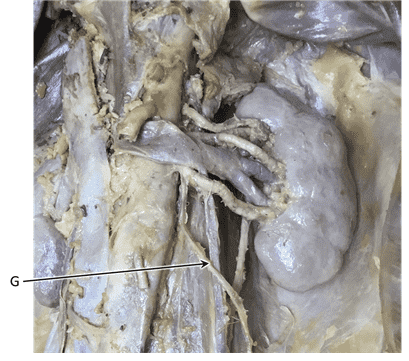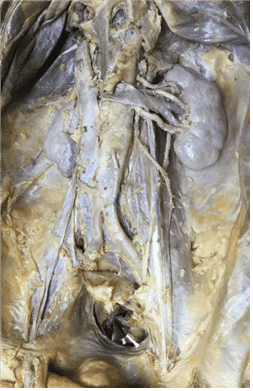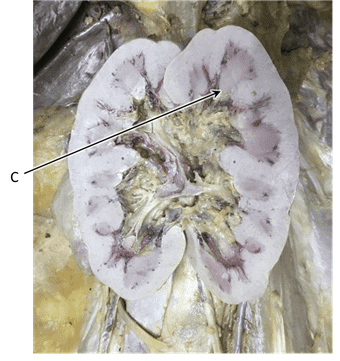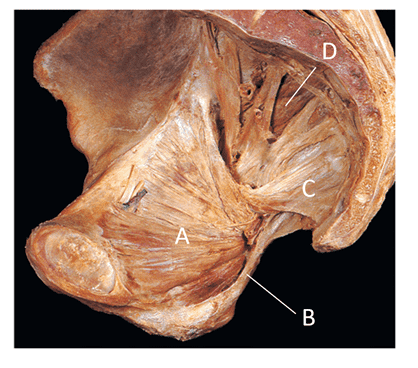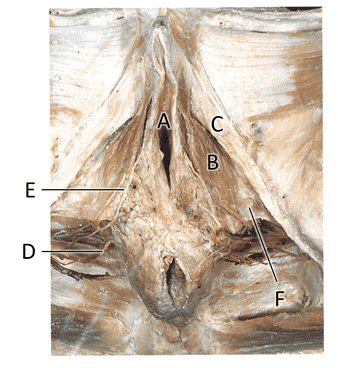Question 1
1. The ________ _________ form the anterolateral borders of the pelvic outlet.
Choices:
- ischiopubic rami
- conjoint rami
- pubic arch
Answers:
- ischiopubic rami
- conjoint rami
- pubic arch
Comments:
- Correct
- That’s right! The conjoint / ischiopubic rami form the anterolateral borders of the pelvic outlet. The “pubic arch” would also be an acceptable answer.
- Continue
Question 2
2. Identify ligament A.
Choices:
- sacrospinous
- sacrospinous ligament
- the sacrospinous ligament
Answers:
- sacrospinous
- sacrospinous ligament
- the sacrospinous ligament
Comments:
- Correct
- That’s right! This is the sacrospinous ligament, which separates the greater sciatic foramen, above, from the lesser sciatic foramen, below.
- Continue
Question 3
3. Identify muscle A.
Choices:
- obturator internis
- obturator internis muscle
Answers:
- obturator internis
- obturator internis muscle
Comments:
- Correct
- That’s right! This is the obturator internis. Notice that its tendon passes out the lesser sciatic foramen.
- Continue
Question 4
4. The urogenital and anal triangles are separated by the ______________ line.
Choices:
- transtubercular
Answers:
- transtubercular
Comments:
- Correct
- That’s right! The transtubercular line separates the urogenital and anal triangles.
- Continue
Question 5
5. The muscular roof of the perineum is the _____________ _____________.
Choices:
- pelvic diaphragm
Answers:
- pelvic diaphragm
Comments:
- Correct
- That’s right! The pelvic diaphragm forms both the floor of the pelvis and the roof of the perineum.
- Continue
Question 6
6. The region immediately superior to the perineal membrane is the _________ _________ ___________.
Choices:
- deep perineal pouch
Answers:
- deep perineal pouch
Comments:
- Correct
- That’s right! The deep perineal pouch is located superior (deep to) the perineal membrane.
- Continue
Question 7
7. The _________ ___________ is a knot of connective tissue located between the urogenital hiatus and the opening for the anal canal.
Choices:
- perineal body
Answers:
- perineal body
Comments:
- Correct
- That’s right! It’s the perineal body.
- Continue
Question 8
8. The perineal spaces lateral to the anal canal are the _________ ___________.
Choices:
- ischioanal fossae
- ischioanal fossa
Answers:
- ischioanal fossae
- ischioanal fossa
Comments:
- Correct
- That’s right! The ischioanal fossae are the spaces of the perineum lateral to the anal canal.
- Continue
Question 9
9. The _________ ___________ ___________ forms the floor of the anterior recesses of the ischioanal fossae.
Choices:
- deep perineal pouch
Answers:
- deep perineal pouch
Comments:
- Correct
- That’s right! The deep perineal pouch forms the floor of the anterior recesses of the ischioanal fossae.
- Continue
Question 10
10. The superficial perineal pouch is limited superiorly by the ________ _________.
Choices:
- perineal membrane
Answers:
- perineal membrane
Comments:
- Correct
- That’s right! The perineal membrane forms the roof of the superficial perineal pouch
- Continue
Question 12
12. The female homologue of the corpus spongiosum are the _____________ of the ______________. (two words, separated by one space)
Choices:
- bulbs vestibule
Answers:
- bulbs vestibule
Comments:
- Correct
- That’s right! In males, the bulbs of the vestibule form a single, fused, midline structure, the corpus spongiosum.
- Continue
Question 13
13. The female homologue of the bulbourethral glands are the _____________ ______________ glands.
Choices:
- greater vestibular
Answers:
- greater vestibular
Comments:
- Correct
- That’s right! The greater vestibular glands are the female homologue of the bulbourethral glands. While the former are located in the superficial perineal pouch, the latter are located in the deep perineal pouch.
- Continue
Question 14
14. Which are skeletal muscles of the superficial perineal pouch? Choose all that apply.
Choices:
- ischiocavernosus
- bulbospongiosus
- external anal sphincter
- external urethral sphincter
Answers:
- ischiocavernosus
- bulbospongiosus
Comments:
- Correct
- That’s right! The bulbospongiosus and ischiocavernosus are skeletal muscles of the superficial perineal pouch. The external urethral sphincter is in the deep perineal pouch and the external anal sphincter is in the anal triangle.
- Continue
Question 15
15. What fibre types are present in the pudendal nerve? Choose all that apply.
Choices:
- sympathetic
- general sensory
- somatic motor
- parasympathetic
Answers:
- sympathetic
- general sensory
- somatic motor
Comments:
- Correct
- That’s right! Like any somatic nerve, the pudendal nerve contains somatic motor, general sensory and sympathetic postganglionic fibres.
- Continue
Question 16
16. Which ONE of the following nerves carries parasympathetic fibres responsible for erection in males?
Choices:
- cavernous nerves
- perineal nerves
- dorsal nerve of the penis / clitoris
- pudendal nerves
Answers:
- cavernous nerves
Comments:
- Correct
- That’s right! The cavernous nerves, derived from the prostatic plexus, carry parasympathetic fibres to the erectile bodies of the superficial perineal pouch.
- Continue
Question 17
17. Which of the following are branches of the pudendal nerves? Choose all that apply.
Choices:
- perineal nerves
- dorsal nerve of the penis / clitoris
- inferior rectal nerves
- cavernous nerves
Answers:
- perineal nerves
- dorsal nerve of the penis / clitoris
- inferior rectal nerves
Comments:
- Correct
- That’s right! These three are somatic nerves of the perineum derived from the pudendal nerves. In contrast, the cavernous nerves carry parasympathetic fibres from the prostatic plexus to the erectile bodies of the superficial perineal pouch.
- Continue
Question 18
18. The ________ ________ sphincter is located at the neck of the urinary bladder.
Choices:
- internal urethral
Answers:
- internal urethral
Comments:
- Correct
- That’s right! The smooth muscle internal urethral sphincter surrounds the neck of the urinary bladder.
- Continue
Question 19
19. The ___________ gland is associated with the terminus of the female urethra.
Choices:
- para-urethral
- paraurethral
- Skene’s
Answers:
- para-urethral
- paraurethral
- Skene’s
Comments:
- Correct
- That’s right! Paraurethral or Skene’s glands are associated with the terminus of the female urethra. Don't confuse them with the greater vestibular glands, which secrete mucus into the vagina in response to sexual arousal.
- Continue
Question 20
20. The the rectal, uterovaginal, prostatic and vesical plexuses are derived from the _____________ _____________ plexus.
Choices:
- inferior hypogastric
Answers:
- inferior hypogastric
Comments:
- Correct
- That’s right! The inferior hypogastric plexus gives rise to nerve plexuses dedicated to pelvic organs.
- Continue
Question 21
21. Arteries to the urinary bladder, uterus and vagina are derived from the _____________ trunk of the _____________ _____________ artery. (three words, each separated by one space)
Choices:
- anterior internal iliac
Answers:
- anterior internal iliac
Comments:
- Correct
- That’s right! Branches of the anterior trunk of the internal iliac artery supply pelvic viscera.
- Continue
Question 22
22. Lymph from pelvic and deep perineal structures drain toward lymph nodes associated with the _____________ _____________ arteries.
Choices:
- internal iliac
Answers:
- internal iliac
Comments:
- Correct
- That’s right! Nodes surrounding the internal iliac artery receive lymph from pelvic and deep perineal structures.
- Continue















